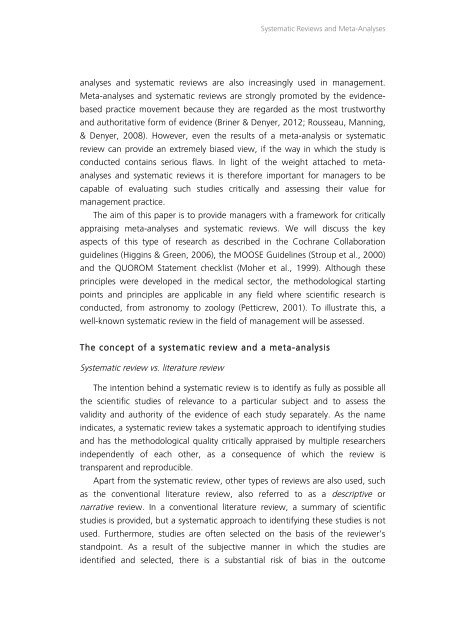In Search of Evidence
jqluvth
jqluvth
You also want an ePaper? Increase the reach of your titles
YUMPU automatically turns print PDFs into web optimized ePapers that Google loves.
Systematic Reviews and Meta-Analyses<br />
analyses and systematic reviews are also increasingly used in management.<br />
Meta-analyses and systematic reviews are strongly promoted by the evidencebased<br />
practice movement because they are regarded as the most trustworthy<br />
and authoritative form <strong>of</strong> evidence (Briner & Denyer, 2012; Rousseau, Manning,<br />
& Denyer, 2008). However, even the results <strong>of</strong> a meta-analysis or systematic<br />
review can provide an extremely biased view, if the way in which the study is<br />
conducted contains serious flaws. <strong>In</strong> light <strong>of</strong> the weight attached to metaanalyses<br />
and systematic reviews it is therefore important for managers to be<br />
capable <strong>of</strong> evaluating such studies critically and assessing their value for<br />
management practice.<br />
The aim <strong>of</strong> this paper is to provide managers with a framework for critically<br />
appraising meta-analyses and systematic reviews. We will discuss the key<br />
aspects <strong>of</strong> this type <strong>of</strong> research as described in the Cochrane Collaboration<br />
guidelines (Higgins & Green, 2006), the MOOSE Guidelines (Stroup et al., 2000)<br />
and the QUOROM Statement checklist (Moher et al., 1999). Although these<br />
principles were developed in the medical sector, the methodological starting<br />
points and principles are applicable in any field where scientific research is<br />
conducted, from astronomy to zoology (Petticrew, 2001). To illustrate this, a<br />
well-known systematic review in the field <strong>of</strong> management will be assessed.<br />
The concept <strong>of</strong> a systematic review and a meta-analysis<br />
Systematic review vs. literature review<br />
The intention behind a systematic review is to identify as fully as possible all<br />
the scientific studies <strong>of</strong> relevance to a particular subject and to assess the<br />
validity and authority <strong>of</strong> the evidence <strong>of</strong> each study separately. As the name<br />
indicates, a systematic review takes a systematic approach to identifying studies<br />
and has the methodological quality critically appraised by multiple researchers<br />
independently <strong>of</strong> each other, as a consequence <strong>of</strong> which the review is<br />
transparent and reproducible.<br />
Apart from the systematic review, other types <strong>of</strong> reviews are also used, such<br />
as the conventional literature review, also referred to as a descriptive or<br />
narrative review. <strong>In</strong> a conventional literature review, a summary <strong>of</strong> scientific<br />
studies is provided, but a systematic approach to identifying these studies is not<br />
used. Furthermore, studies are <strong>of</strong>ten selected on the basis <strong>of</strong> the reviewer’s<br />
standpoint. As a result <strong>of</strong> the subjective manner in which the studies are<br />
identified and selected, there is a substantial risk <strong>of</strong> bias in the outcome


